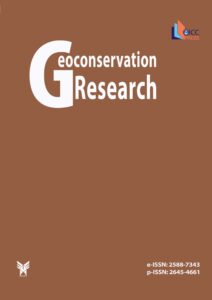The Armorican Quartzite: when trilobites ruled the Ordovician seas of the Villuercas-Ibores-Jara UNESCO Global Geopark, Spain
Authors
Abstract
Cruziana is a common and widespread trace fossil in Lower Palaeozoic strata that is generally attributed to the activity of trilobites. The Lower to Middle Ordovician Armorican Quartzite Formation of southern Europe contains well-preserved examples of the Cruziana rugosa Group. This paper outlines how Cruziana forms an important part of the geological heritage in the Villuercas-Ibores-Jara UNESCO Global Geopark, Cáceres Province (SW Spain).
Read the full text of the articleKeywords
Main Subjects
References
Bayet-Goll A & Neto de Carvalho C (2020). Architectural evolution of a mixed-influenced deltaic succession: Lower-to-Middle Ordovician Armorican Quartzite in the south-west Central Iberian Zone, Penha Garcia Formation (Portugal). International Journal of Earth Sciences. 109: 2495–2526.
Egenhoff S, Weber B, Lehnert O & Maletz J (2007). Biostratigraphic precision of the Cruziana rugosa group: a study from the Ordovician succession of southern and central Bolivia. Geological Magazine. 144: 289–303.
Fortey RA & Seilacher A (1997). The trace fossil Cruziana semiplicata and the trilobite that made it. Lethaia. 30: 105–112.
Goldring R (1985). The formation of the trace fossil Cruziana. Geological Magazine. 122: 65–72.
Gutiérrez-Marco JC, García-Bellido DC, Rábano I & Sá A A (2017). Digestive and appendicular soft-parts, with behavioural implications, in a large Ordovician trilobite from the Fezouata Lagerstätte, Morocco. Scientific Reports. 7: 39728.
Meischner T, Elicki O, Masri A, Al Moumani K & Ali Hussein MA (2020). Ordovician trace fossils from southern Jordan with particular consideration to the Cruziana rugosa Group: taxonomy, stratigraphy and trans-regional correlation throughout Middle East and northern Africa. Journal of African Earth Sciences. 164: 103595.
Neto de Carvalho C (2006). Roller coaster behavior in the Cruziana rugosa Group from Penha Garcia (Portugal): implications for the feeding program of trilobites. Ichnos. 13: 255–265.
Neto de Carvalho C & Baucon A (2016). Giant trilobite burrows and their paleobiological significance (Lower-to-Middle Ordovician from Penha Garcia, Portugal). Comunicacões Geológicas. 103(Especial I): 71–82.
Neto de Carvalho C, Baucon A, Bayet-Goll, A, Belo, J. (2021). The Penha Garcia Ichnological Park at Naturtejo UNESCO Global Geopark (Portugal): a geotourism destination in the footprint of the Great Ordovician Biodiversification Event. Geoconservation Research. 4(1):*** doi: 10.30486/gcr.2021.1913338.1051
Sá A A, Valerio M, Santos C, Magalhaes T, Almeida P (2006). Novos dados para o conhecimento dos icnofósseis da Formação Santa Justa (Arenigiano, Ordovícico Inferior) na região de Arouca (Zona Centro-Ibérica, Portugal Central). Geonovas. 20: 17–32.
Sá A.A, Gutiérrez-Marco JC, Rocha D, Valério M, Brilha J & Rábano I (2009). Ordovician ichnofossils: a new scientific and educational resource for the Arouca Geopark. In Neto de Carvalho C & Rodrigues J (eds.), New Challenges in Geoturism. Proceedings of the VIII European Geoparks Conference (pp. 140–142).
Sá A. A, Gutiérrez-Marco JC, Meireles CA, Garcia-Bellido DC & Rábano I (2014). A revised correlation of Lower Ordovician sedimentary rocks in the Central Iberian Zone (Portugal and Spain). In: R Rocha et al. (eds.), STRATI 2013: 441–445. Springer.
Seilacher A (1970). Cruziana stratigraphy of 'non-fossiliferous' Palaeozoic sandstone. In: Crimes TP, Harper JC (eds.), Trace Fossils (pp. 447–476). Liverpool: Seel House Press.
Seilacher A (2007). Trace fossil analysis. Berlin, Heidelberg: Springer Verlag.
Simón-Porcar G, Martínez-Graña A, Simón JL, González-Delgado J & Legoinha P (2020). Ordovician ichnofossils and popular architecture in Monsagro (Salamanca, Spain): ethnopaleontology in the service of rural development. Geoheritage.12: 76.




